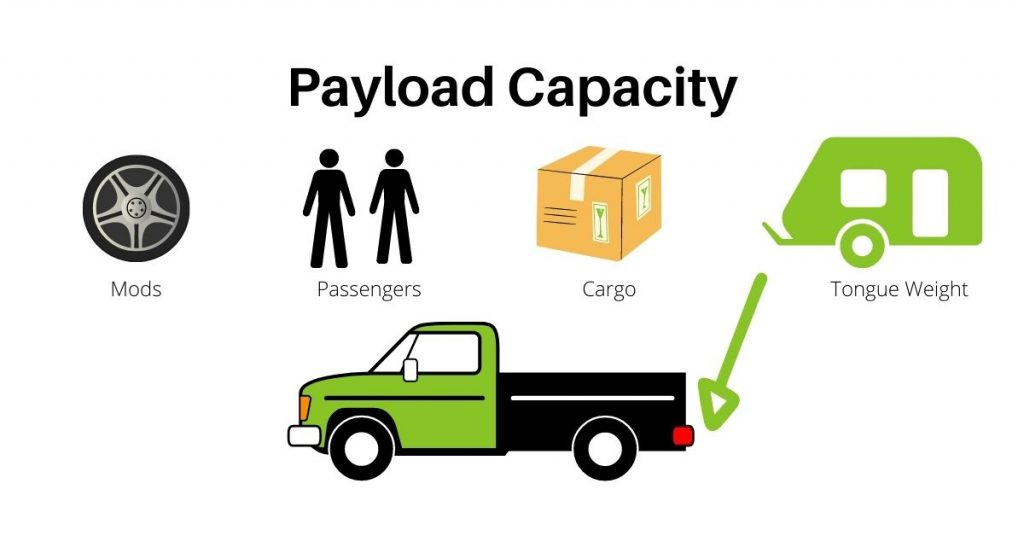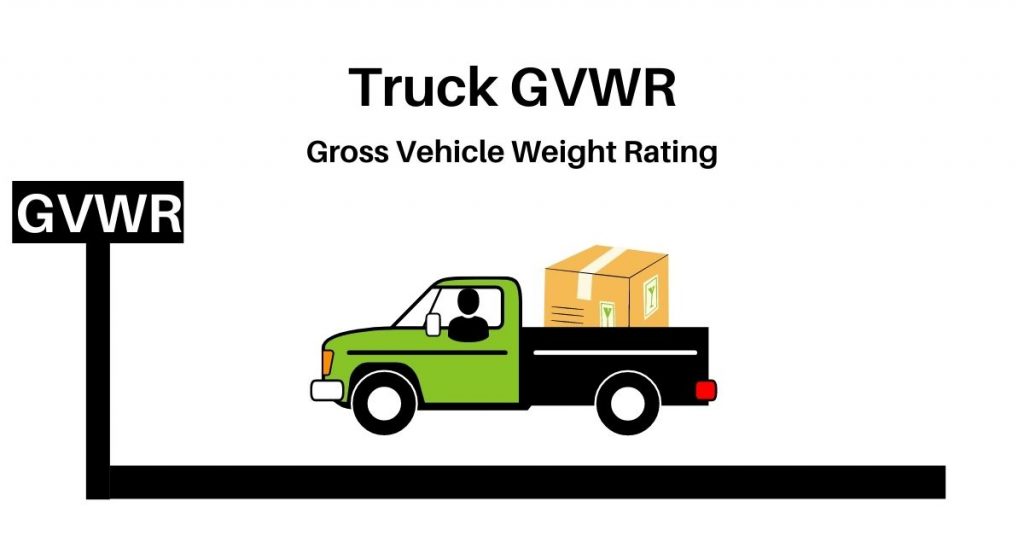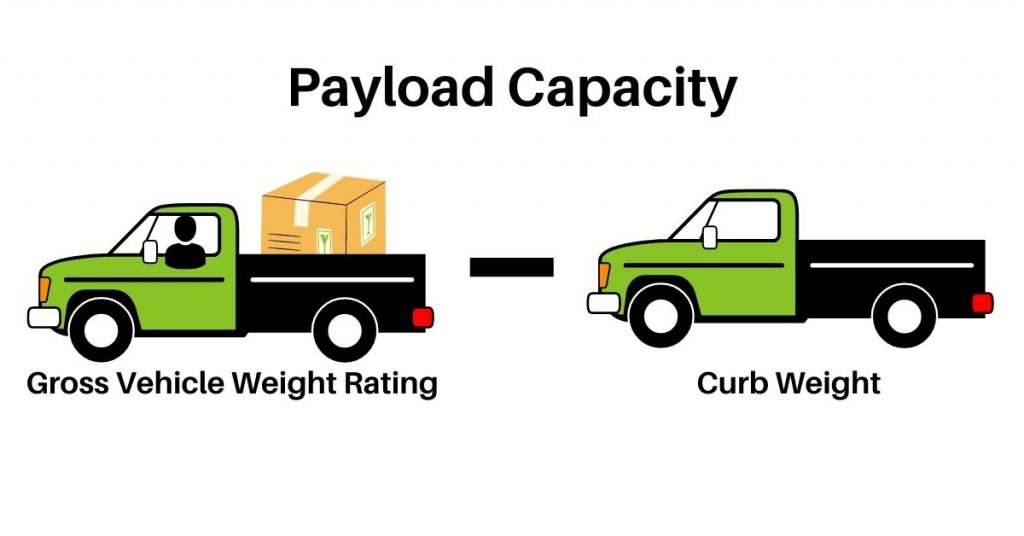The Ford F-150 Payload Capacity for the 2021 model ranges from 1,705 lbs to 3,325 lbs based on engine, cab type, payload package and bed size.
Without an extra payload package the maximum payload capacity is 2,620 lbs on the base Limited, Tremor or Raptor with 2 wheel drive, a regular cab and an 8 ft bed.
This article displays all the payload specs provided by Ford organized by bed size and model.
You will also find a detailed description of what payload capacity really is along with a payload capacity calculator if your truck isn’t listed here.
Payload capacity refers to the amount of weight that a truck can carry, if you are looking for the towing capacity, check out this article.

Payload Capacity by Model
There are 8 models of the Ford F150.
- XL
- XLT
- LARIAT
- King Ranch
- Platinum
- Limited
- Tremor
- Raptor
Each of these models has a standard engine. If you did not customize the engine type of your truck, then the chart below will tell you the specific payload capacity of your truck by model and size (in lbs).
| Drive | SuperCrew | SuperCrew | Regular | Regular | Super | Super | |
| Model | 5.5 ft | 6.5 ft | 6.5 ft | 8.0 ft | 6.5 ft | 8.0 ft | |
| XL/XLT | 4×2 4×4 | 1,785 1,765 | – | 1,985 1,775 | 1,975 1,960 | 1,905 1,880 | – |
| LARIAT | 4×2 4×4 | 1,815 1,760 | 1,830 – | 1,875 1,705 | 1,905 1,885 | 1,885 1,745 | 1,925 – |
| King Ranch Platinum | 4×2 4×4 | 2,135 2,135 | 2,235 2,135 | 1,900 1,835 | 2,350 2,300 | 2,345 2,240 | 2,325 2,205 |
| Limited Tremor Raptor | 4×2 4×4 4×4 | 2,050 2,100 1,885 (Tremor) | 2,245 2,155 | – | 2,620 2,360 | 2,290 2,190 | 2,285 2,125 |
Payload Capacity by Cab Type
There are three main cab types in the Ford F-150 family.
The first is the regular cab. This is a single-row cabin with only 2 full doors.
The Super Cab is a double-row cabin with 4 doors, but only 2 full doors. The others open backward and do not have their own handles.
The SuperCrew cab is also a double row cabin but has 4 full doors and therefor has a shorter bed size.
The Regular Cab and Super Cab have bed sizes of 6.5 ft and 8 ft whereas the SuperCrew only has 5.5 ft and 6.5 ft.
Below you will find the payload capacity by cab, drive, and engine.
Regular Cab Payload Capacity
| Engine Drive | 6.5 ft 4×2 | 6.5 ft 4×4 | 8 ft 4×2 | 8 ft 4×4 |
| 3.3L Ti-VCT V6 | 1,985 lbs | 1,775 lbs | 1,975 lbs | 1,960 lbs |
| 2.7L EcoBoost V6 (with Payload Package) | 1,875 lbs | 1,705 lbs | 1,905 lbs (2,480 lbs) | 1,885 lbs (2,125 lbs) |
| 5.0L Ti-VCT V8 (with Payload Package) | 1,900 lbs | 1,835 lbs | 2,350 lbs (3,325 lbs) | 2,300 lbs (3,050 lbs) |
| 3.5L EcoBoost V6 (with Payload Package) | – | – | 2,620 lbs (3,250 lbs) | 2,360 lbs (3,035 lbs) |
Super Cab Payload Capacity
| Engine | 6.5 ft 4×2 | 6.5 ft 4×4 | 8 ft 4×2 | 8 ft 4×4 |
| 3.3L Ti-VCT V6 | 1,905 lbs | 1,880 lbs | – | – |
| 2.7L EcoBoost V6 (with Payload Package) | 1,885 lbs (2,175 lbs) | 1,745 lbs (2,165 lbs) | 1,925 lbs (2,225 lbs) | – |
| 5.0L Ti-VCT V8 (with Payload Package) | 2,345 lbs | 2,240 lbs | 2,325 lbs (3,010 lbs) | 2,205 lbs (2,765 lbs) |
| 3.0L Power Stroke V6 | – | 1,840 lbs | – | – |
| 3.5L EcoBoost V6 (with Payload Package) | 2,290 lbs | 2,190 lbs | 2,285 lbs (2,980 lbs) | 2,125 lbs (2,740 lbs) |
SuperCrew Payload Capacity
| Engine | 5.5 ft 4×2 | 5.5 ft 4×4 | 6.5 ft 4×2 | 6.5 ft 4×4 |
| 3.3L Ti-VCT V6 | 1,785 lbs | 1,765 lbs | – | – |
| 2.7L EcoBoost V6 (with Payload Package) | 1,815 lbs (1,960 lbs) | 1,760 lbs (1,965 lbs) | 1,839 lbs (2,085 lbs) | – |
| 5.0L Ti-VCT V8 (with Payload Package) | 2,135 lbs 2,335 (Max Trailer Pkg) | 2,135 lbs | 2,235 lbs (2,900 lbs) | 2,135 lbs (2,650 lbs) |
| 3.0L Power Stroke V6 | – | 1,805 lbs | – | 1,805 lbs |
| 3.5L EcoBoost V6 (with Payload Package) | 2,050 lbs | 2,100 lbs 1,885 lbs (Tremor) | 2,245 lbs (2,880 lbs) | 2,155 lbs (2,640 lbs) |
| 3.5L EcoBoost V6 Raptor | – | 1,410 lbs | – | – |
| 3.5L PowerBoost Hybrid V6 | 2,090 lbs | 1,830 lbs | 2,120 lbs | 1,810 lbs |
What is Payload Capacity?

Payload capacity is simply the weight that can be added to a base truck. This means that the total weight of people, body modifications, cargo, and tongue weight.
Tongue weight is the amount of force that is exerted on the hitch of a pickup from a trailer on the hitch ball.
How much weight can you put in a Ford F150 bed?
After you determine the payload capacity of your car, you will now know the extra amount of weight allowed in the truck.
The payload capacity minus the passenger weight is the amount that can be put in the bed of a truck.
Assuming a driver of 180 lbs, a Ford F150 can carry between 1,525 lbs and 2,440 lbs depending on the model.
Payload Capacity vs GVWR
Every truck has a safe weight limit for which the truck can safely handle. This total weight is known as the GVWR.
GVWR stands for the gross vehicle weight rating. This is a number provided by the manufacturer that specifies the total weight that a truck can be (by engine, model and size).
The GVWR is the total weight that a loaded truck can have including:
- passengers
- cargo
- truck body
- modifications
- tongue weight
So what’s the difference between GVWR and Payload capacity?
Payload capacity actually refers to the amount of weight that can be safely carried by a truck.
The GVWR is the maximum weight that a truck, in total can weigh, with its passengers and cargo.

How to calculate Payload Capacity?
Though GVWR and payload capacity are different, they are very closely related. The GVWR is used to calculate the payload capacity.
Another important metric to understand payload capacity is the curb weight. The curb weight is defined as the base weight that a truck has (with gas) without any additional cargo or modifications.

In order to calculate the payload capacity, you need BOTH the GVWR and the curb weight.
Payload capacity is calculated by subtracting the curb weight from the GVWR.
Payload Capacity = GVWR – Curb Weight
Need to find the curb weight of your Ford F-150? Check out How Much Does a Ford F150 weigh
Here’s an example: Ford F150 XL base model with 6.5 ft box and 4×4 wheel drive.
Curb weight: 4,275 lbs
GVWR: 6,050 lbs
Payload Capacity = 6050-4275 = 1,775 lbs
Payload Capacity Calculator
With this payload capacity calculator, you can determine the maximum load that can go on your vehicle by using the GVWR and the curb weight.
Can My Truck Carry It?
You can determine whether your truck can handle your additions by using the calculator below. You will need:
- GVWR
- Curb Weight
- Passenger Weight
- Cargo Weight
- Customization Weight (If added)
- Tongue Weight of Trailer (if applicable)
If you do not have a specific tongue weight of your trailer, they should be 10-15% of the total trailer weight.
Payload capacity was historically used to help categorize trucks. Trucks use to be identified by payload capacity as being a half-ton, quarter-ton or one-ton truck.
This weight refers to the amount that each rating can carry in their truck. Click here for more information about what each of these means and how these ratings are currently used for pickup trucks.
How is Payload Capacity different than Towing Capacity?
It is important to note that payload capacity and towing capacity are two completely different things.
A more detailed explanation can be found in this article to help you understand the difference between carrying and towing capacity.
Payload capacity refers to the amount of additional weight that can be added to a truck whereas towing capacity refers to the amount of weight that can be pulled by a truck.
Payload capacity is the difference between the curb weight and the GVWR.
The towing capacity is the difference between the curb weight and the GCWR.
The GCWR stands for the Gross Combined Weight Rating.

This is the maximum weight that your vehicle and trailer can weigh. This includes passengers, cargo, the curb weight of the vehicle, the trailer weight, and any trailer cargo.
Want more information on how to calculate towing capacity? READ HERE!
Read the Ford F150 Towing Capacity Guide for information on towing.
Please share this article if you found it useful! These calculators can come in handy one day!


